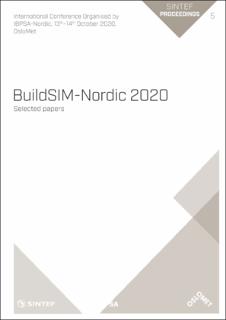| dc.contributor.author | Nickl, Christoph | |
| dc.contributor.author | Clauß, John | |
| dc.contributor.author | Georges, Laurent | |
| dc.date.accessioned | 2020-10-22T07:56:44Z | |
| dc.date.available | 2020-10-22T07:56:44Z | |
| dc.date.created | 2020-10-15T15:52:23Z | |
| dc.date.issued | 2020 | |
| dc.identifier.isbn | 978-82-536-1679-7 | |
| dc.identifier.uri | https://hdl.handle.net/11250/2684341 | |
| dc.description.abstract | This work evaluates the influence of the heating distribution system on the energy flexibility of highly insulated single-family residential buildings. The behavior of three different systems (air heating, radiator heating, and floor heating) is assessed for schedule-based and price-based rule-based control of the heating system aiming at peak shaving and cost reduction. Dynamic building performance simulations are performed in the software tool IDA ICE.
The investigated controls activate the thermal mass and water storage tanks. When activating only the thermal mass, the energy use during peak hours decreases by nearly 10% in the radiator heating cases, in the air heating cases the effect is less pronounced and shows little to no shifting potential. In the floor heating cases, a slight decrease in energy use is found for the price-based control, whereas a slight increase is observed with a schedule-based control.
In contrast, when domestic hot water and space heating tank set points are adjusted, the energy use during peak hours decreases in all versions. The schedule-based control achieve reductions between 20% to 30% among the different heat emission systems. The price-based control however, is less effective, leading to lower reductions in energy use. The total energy use and operational costs increase in each case, most pronounced with the schedule-based set point variations for the domestic hot water and space heating tank.
It is found that a good demand response measure is not only dependent on a correct selection of the set point at the supervisory control level, but also a good implementation of the local controller that considers the thermal dynamics of the heating system is required. | en_US |
| dc.language.iso | eng | en_US |
| dc.publisher | SINTEF akademisk forlag | en_US |
| dc.relation.ispartof | International Conference Organised by IBPSA-Nordic, 13th–14th October 2020, OsloMet. BuildSIM-Nordic 2020. Selected papers | |
| dc.rights | Attribution-NonCommercial-NoDerivatives 4.0 Internasjonal | * |
| dc.rights.uri | http://creativecommons.org/licenses/by-nc-nd/4.0/deed.no | * |
| dc.title | Influence of space heating distribution systems on the energy flexibility of Norwegian residential buildings | en_US |
| dc.type | Chapter | en_US |
| dc.description.version | publishedVersion | en_US |
| dc.source.pagenumber | 114-122 | en_US |
| dc.identifier.cristin | 1839903 | |
| dc.description.localcode | © The authors. Published by SINTEF Academic Press 2020 This is an open access publication under the CC BY-NC-ND license (http://creativecommons.org/licenses/by-nc-nd/4.0/). | en_US |
| cristin.ispublished | true | |
| cristin.fulltext | original | |
| cristin.fulltext | original | |

